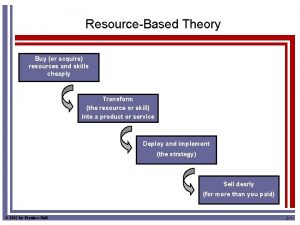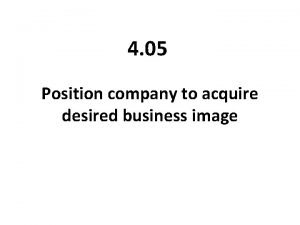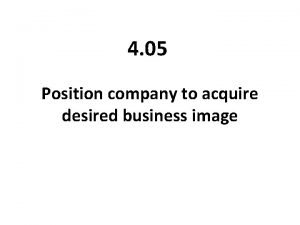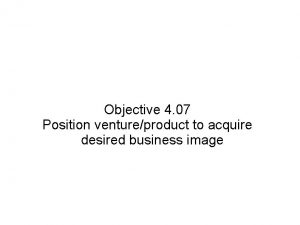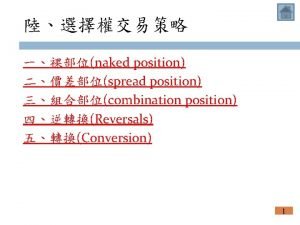3 04 A POSITION PRODUCTSSERVICES TO ACQUIRE DESIRED



























- Slides: 27

3. 04 A POSITION PRODUCTS/SERVICES TO ACQUIRE DESIRED BUSINESS IMAGE

COMPETITIVE ADVANTAGE & POSITIONING • Competitive Advantage – the set of unique features of a company and its products that are perceived by the target market as significant and superior to the competition. • Positioning – developing a specific marketing mix to influence potential customers’ overall perception of a brand, product line or organization in general

PURPOSE of Positioning • Marketers use positioning to find a place for the product in the marketplace and to distinguish the product from competitors. • The actual position is how the customers SEE the product. The positioning and the actual position of the product are the same, if marketing has been successful.



Relationship between Target Market and Positioning. • The objective is for marketers to position their products to appeal to the desires and perceptions of a target market.

Market Position • A unique image of a product or service in a consumer’s mind relative to similar competitive offerings.

Types of Positioning Strategies Product Attributes Benefits Usage Users Competition Product Classes

6 Common Bases for Positioning • Attribute- one way of positioning a product is to highlight a product feature or attribute. • Benefits/Price and Quality – this position strategy may stress high price as a sign of quality, or emphasize low price as an indication of value. • Usage– stressing unique uses or applications can be an effective means of positioning a product.

6 Common Bases for Positioning (cont’d) • Product Users – this positioning strategy encourages use of a product or service by associating a personality or type of user with the product. • Competitor – sometimes marketers make an effort to demonstrate how they are positioned against the competitors that hold a strong market position. • Product Classification – when positioning according to product class, the objective is to associate the product with a particular category of products.

BLOG-- Positioning STRATEGY • Outlines how a company is going to PRESENT its product or service to the consumer and how it will COMPETE in the marketplace.

3. 04 B GET OUT NOTES FROM YESTERDAY!

All About Brands • What is a Brand? • A Brand is a design, symbol, term, or word that identifies a company or product

All About Brands • Brand Name - recognizable brand with high level of brand equity • Brand Symbol – a distinctive symbol that represents the company or product. Brand SYMBOL Brand NAME

TRADE CHARACTER • personified symbol to represent brand name • Walks & talks like a person.

• Co-Branding • Occurs when companies join forces to increase recognition, customer loyalty, and sales of both brands. • Example -- KFC and Pizza Hut in the same building, etc. It benefits both companies and increases their profits • Family branding • Involves using the same brand for related products in a product line.

3. 04 BRANDING (ACTIVITY 1) • BRAND SYMBOL Using magazines/ newspapers • BRAND NAME FIND examples of each. Paste and label on • SLOGAN paper given. • TRADE CHARACTER • CO-BRANDING *Example on next slide. • FAMILY BRANDING

CO-BRANDING 2 different companies- Betty Crocker & Hershey's Family Branding Brand NAME Slogan Trade Character Brand SYMBOL Trade Character

FORMS OF BRANDING • A National BRAND represents the entire company or organization • AKA Manufacturers or Corporate • For example, Coca-Cola, Mc. Donalds, Kraft or Microsoft

FORMS OF BRANDING • A PRODUCT BRAND represents a specific product of a company or organization • For example, Diet Vanilla Coke, Big Mac, or Windows XP

• GENERIC: • Unbranded products that are plainly packaged, have lower or standard quality, lower prices, and receive little or no promotion

FORMS OF BRANDING • A PRIVATE DISTRIBUTOR BRAND, also called a store brand • For example, Radio Shack brand of batteries, Food Lion brand of macaroni and cheese

Characteristics of a Good Brand Name The name should describe the product’s benefits and uses. The name should be easy to read, pronounce, and remember. The name should create appealing images. The name should be distinctive. The name should be legally available for use. The name should be appropriate for packaging and advertising.

Levels of Brand Loyalty • Recognition: • When consumers become aware of a brand know a bit about it • Preference: • When consumers prefer to purchase a certain product brand based on their positive experience with the brand. • Insistence: • When the consumer insist on “their” brand will not accept substitutes.

Branding Strategies • What are Branding Strategies? • Actions that need to be taken with an established brand, in order to accomplish its goals. • Brand Positioning: • The way consumers see the brand, as compared to a competitive brand. • Brand Extensions: • When a brand name is used for a new or improved product line. • Brand Licensing: • Allows one company to use another’s brand name, logo, or character for a fee. • Co-Branding • Occurs when companies join forces to increase recognition, customer loyalty, and sales of both brands.

ACTIVITY 2 DIVIDE YOUR PAPER INTO 3 EQUAL PARTS. LABEL THE TOP & FIND 3 EXAMPLES OF EACH LISTED BELOW. • Manufacturers/National brand • Product brand (specific product) • Private Distributor brand/ Store brand (You will probably need to use sale papers to find examples. )

 Second position
Second position How did jay gould spend his money
How did jay gould spend his money Acquire
Acquire Three principles of acquiring spiritual knowledge
Three principles of acquiring spiritual knowledge Frequency modulation and demodulation theory
Frequency modulation and demodulation theory Merge vs acquire
Merge vs acquire Pre assignment tools
Pre assignment tools How do humans acquire language
How do humans acquire language Advapi
Advapi Acquire project team
Acquire project team Acquire collocation
Acquire collocation Acquire resources
Acquire resources Fundamental position vs anatomical position
Fundamental position vs anatomical position How many fundamental starting position
How many fundamental starting position Mcm package
Mcm package Margin of safety in units
Margin of safety in units Drug calculation formula
Drug calculation formula What are the characteristics of rubrics
What are the characteristics of rubrics A(n) is a desired end toward which efforts are directed.
A(n) is a desired end toward which efforts are directed. Peep in ventilator
Peep in ventilator Desired results parent survey
Desired results parent survey Marginal costing vs variable costing
Marginal costing vs variable costing Dosage on hand formula
Dosage on hand formula Inherent risk
Inherent risk Duncker diagram
Duncker diagram Partnership advantages
Partnership advantages Professional image definition
Professional image definition Normal minute ventilation
Normal minute ventilation











